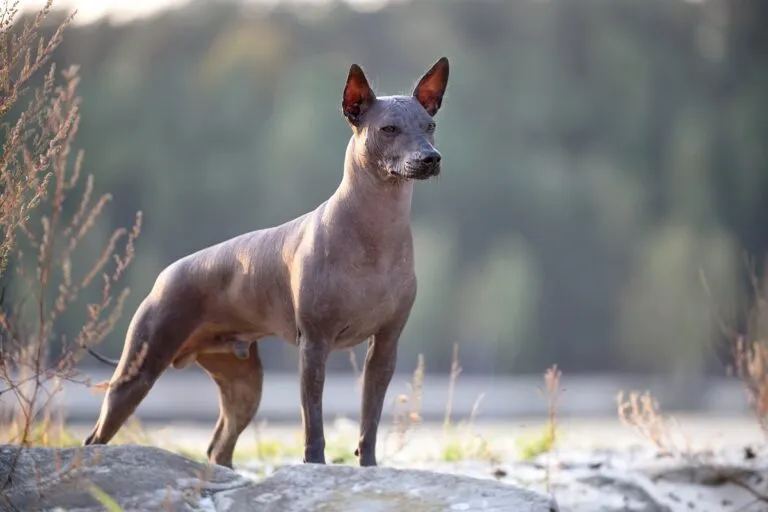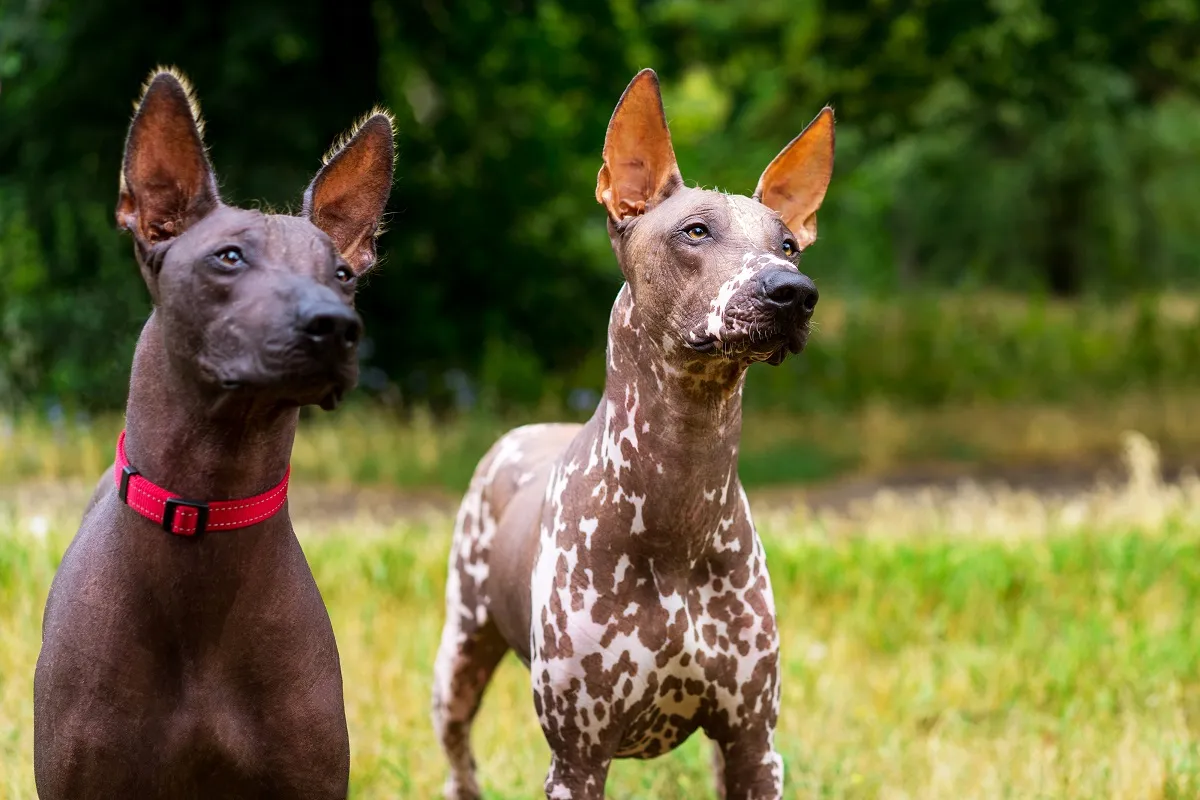Medium Size Poodle
The Mexican Hairless Dog, or Xoloitzcuintle, is one of the oldest dog breeds on the American double continent. The hairless representatives of this breed are especially well known, but there are also coated examples. These friendly, calm four-legged friends make excellent companion and family dogs and, in some cases, can even be suitable for people with allergies.

© niknikp / stock.adobe.com
Broad chest, elongated body, triangular ears: these are the characteristics that distinguish the Mexican Hairless Dog.
The Xoloitzcuintle is also known as the Xolo or Mexican Hairless Dog. However, not all dogs of this breed are actually hairless. According to the breed standard, the hairless variety may have small tufts of hair on the forehead and at the tip of the tail. The skin is thick, smooth, and soft. It can be black, grey, or brown, and spotted dogs also occur.
In addition, there is a fully coated variety with short fur. The possible coat colours match the skin colours of the hairless Xoloitzcuintle.
The Mexican Hairless is characterised by its elongated, muscular build, broad chest, and bat-like, triangular ears. The breed is bred in three sizes:
The lack of fur in this hairless dog breed is due to a genetic defect caused by a natural mutation. This altered gene also affects tooth development, which is why the hairless Xoloitzcuintle may be missing some or even all teeth. Coated representatives of the breed, on the other hand, have a full set of teeth.
Furthermore, hairlessness is known as a so-called lethal factor. This means that if two hairless dogs of this breed are mated, many puppies die in the womb.
Due to these health issues, some animal welfare advocates believe the Mexican Hairless meets the criteria for extreme breeding. However, breeding and keeping this breed is not prohibited.
 © Masarik / stock.adobe.com
© Masarik / stock.adobe.com
As a friendly, calm companion, the Xoloitzcuintle fits harmoniously into family life. With other dogs, cats, and children, this sociable Mexican usually gets along well. The breed is described as intelligent and adaptable. Thanks to its balanced nature, the Xolo is generally suitable for first-time dog owners.
The Mexican Hairless Dog is affectionate and loving towards its owners. When meeting strangers, however, it tends to be somewhat cautious. It is alert and watchful, but never aggressive.
These qualities make it a reliable family, companion, and guard dog.
The Xoloitzcuintle is a sensitive dog that needs to be trained with plenty of patience and gentle consistency. When the Mexican Hairless Dog feels emotional stress, it displays a remarkable behaviour: tears run down its face.
This exotic four-legged friend loves being outdoors, so it really enjoys living in a house with a garden. In general, the undemanding Xoloitzcuintle also copes well with living in a flat.
As it is very people-oriented, it should not be left alone for long periods. Kennel keeping, separated from its people, is not suitable for this affectionate Mexican.
An active, clever dog like the Mexican Hairless loves long walks as well as intelligence and food-searching games. It can also be enthusiastic about various dog sports such as agility, obedience, and dog dancing. It also makes a great companion for jogging, hiking, or cycling.
Thanks to its lack of fur, the Mexican Hairless Dog may also be suitable for people with allergies. However, there is no guarantee of compatibility, as allergy symptoms are not caused by the hair itself, but by skin flakes or saliva.
Before bringing a Xolo home, allergy sufferers should thoroughly test whether living together is possible.
The skin of the Mexican Hairless Dog is prone to impurities and skin conditions and therefore needs special care.
At regular intervals, the dog’s skin should be rubbed with a mild lotion to keep it moisturised. Any injuries must be disinfected and treated with a wound ointment.
Dirt can be wiped off with a damp cloth. In summer, especially the lighter skin areas must be protected from sunburn with sun cream. As the hairless representatives of the breed have genetic dental problems, they should be accustomed to tooth brushing from puppyhood.
Due to the lack of fur, the naked Xolo needs more energy to maintain its body temperature. It is therefore advisable to feed high-quality food in several small portions throughout the day. Overweight should be avoided.
For dogs with jaw deformities or dental problems, soft wet food is better suited than hard dry food. They can chew it more easily, which is important for digestion and nutrient intake.
Despite missing teeth, the Xolo also needs soft chews to gnaw on.
As already mentioned, the hairlessness of the Xoloitzcuintle is associated with certain health issues. These include a tendency towards dental problems and an increased risk of skin diseases.
Parasites actually have a surprisingly hard time on its thick, robust skin.
With strong sunlight, especially in light-skinned representatives of the breed, there is a risk of sunburn. Therefore, light skin areas should be protected with sun cream. A light coat can also provide protection.
Good to know: Like all other dogs, the Xolo only sweats through its paw pads, not over its whole (naked) body.
With good care, this exotic breed can live to around twelve to fifteen years.
Despite being hairless, the Xoloitzcuintle is not overly sensitive to cold, so this hardy dog can also be kept in cooler regions.
Nevertheless, it is advisable to put a coat on it in extremely cold weather. If the Mexican Hairless Dog gets cold, it will start to shiver.
The Mexican Hairless Dog is by no means a modern breed – it is actually one of the oldest dog breeds in the Americas, and possibly even worldwide.
Hairless dogs have been known in Mexico for about 3,500 years. The oldest depiction of the Xolo, a clay figurine, is dated to around 1700 BC.
Back then, the Xoloitzcuintle was probably highly regarded. In particular, it served as a “living hot water bottle” for the sick. It was believed to help relieve health problems such as colds, rheumatism, and asthma.
The name Xoloitzcuintle comes from the Aztec language Nahuatl and is pronounced sholo-its-queent-ly. The somewhat complicated name translates as “dog of the god Xolotl”.
The Mexican Hairless Dog was therefore considered the earthly representative of Xolotl, the Aztec god of lightning, misfortune, and death.
The task of this highly revered dog was to accompany the dead to the afterlife. Mummified animals have been found that were placed in graves with the deceased. On special occasions, the Xolo was also sacrificed and its meat eaten as a delicacy.
Breeding them requires a lot of expertise, as there are some special considerations. If two hairless dogs are mated, the hairless embryos die in the womb. This is because the gene defect that causes hairlessness is a so-called lethal factor.
Therefore, one hairless and one coated Xolo must be selected as parents. The offspring will then be half hairless and half coated. Coated dogs must not be mated with each other.
The Xoloitzcuintle is an officially recognised dog breed, classified by the international canine organisation FCI in group 5 “Spitz and primitive type dogs”.
Through crossbreeding with European companion dogs, the Chinese Crested Dog was probably developed. The Xolo is also closely related to the Peruvian Hairless Dog.
The Xoloitzcuintle is an exotic breed that is sure to stand out at the dog park or in dog training classes. Its hairless appearance divides opinion: at competitions for the “ugliest dog in the world”, dogs of this breed often take the top spots.
However, its health is far more important than its looks. Anyone wanting to welcome a Xolo into their family should always go to a reputable breeder and take good care of the dog’s bare skin.
| Special features: | The Xoloitzcuintle is an ancient dog breed from Mexico. There are both coated and hairless representatives of the breed. |
| Character: | friendly, affectionate, calm, intelligent |
| Height at withers: | Standard: 46-60 cm (+2 cm tolerance) Medium: 36-45 cm Miniature: 25-35 cm |
| Weight: | 4-25 kg |
| Coat: | hairless or short coat Coat or skin colour: black, grey, liver or bronze, pink or coffee-coloured spots possible |
| Skin care: | moderate effort |
| Exercise: | enjoys being outdoors, activities such as agility or obedience |
| Suitable for beginners: | yes |
| Barking: | alert, barks to announce visitors |
| Life expectancy: | 12-15 years |
| Typical illnesses: | dental problems, skin conditions, wounds |
| FCI group: | 5 “Spitz and primitive type dogs” |
| Exercise needs: | moderate |
| Origin: | Mexico |
Fans of the Bearded Collie agree that those who aren't familiar with this dog breed simply have to get acquainted with it. And those who have experienced how a Bearded Collie bolts across meadows with its flowing fur, how it rolls around full of energy and joy and how it attentively and observantly takes into account its owners wishes become simply addicted to this original dog breed and its unique charm.
The Goldendoodle isn't a breed, but a pairing between Golden Retrievers and Medium or Standard Poodles. Marketed as a low-maintenance dog for allergy sufferers, this hybrid is enjoying increasing popularity amongst dog lovers, similar to the Labradoodle.